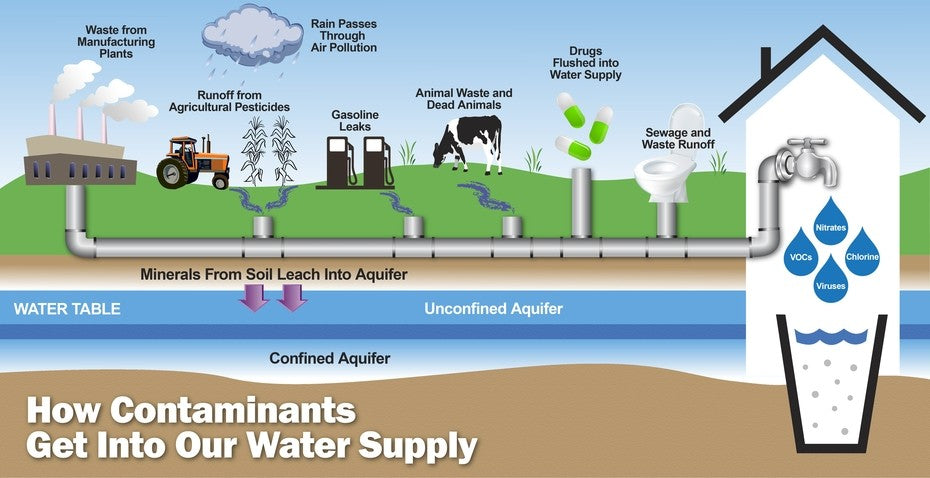
llustration © Copyright 2013 Fresh Water Systems, Inc. All Rights Reserved.
Water in your faucet may pick up contaminants on its journey to the tap. While your water may leave the treatment plant without contaminants, it collects them from gas leaks, animal waste, sewage waste, and runoff along the way. In some cases, your water supply could originate from an unregulated well. The government does not regulate a privately-owned well. The home owner has the responsibility to treat and filter it for safe water.
Why should I be concerned about my drinking water?
Tap water generally comes from two primary sources: municipal water treatment facilities and private wells (or ponds).
- Municipal water treatment facilities
Municipal facilities are required to meet certain federal standards by the EPA and test for certain dangerous contaminants. As long as the water is below the maximum contaminant levels issued by the EPA, these facilities are permitted to deliver water to customers. These levels, however, may still be harmful, especially to those the elderly, pregnant women, children, or individuals with compromised immune systems.
Even though water leaving the municipal water facility may be safe, contaminants in large distribution pipes or household plumbing can enter the tap water. Some contaminants may be so new that federal contaminant guidelines have yet to be issued, like those for the cancer-causing Chromium 6 (commonly known as the Erin Brockovich contaminant). Also, municipalities may not detect pipes or older systems that leak contaminants into the water supply. These leaks generally require a boil water advisory issued to the public
- Private wells and ponds
Private wells and ponds are not regulated by local or federal governments. The owner of the source of water (private well or pond) is responsible for the quality of the water. As seen in the illustration above, many sources cause contaminants to leak into groundwater and enter the well, including nitrates from fertilizer used on farms, sewage overflow from local flooding, and chemical leaks from manufacturing.
What effects can contaminated water have on my health?
Each contaminant is caused by a different source. Your water may contain pesticides because of agricultural run-off. E. coli and other bacteria found in fecal matter may seep into your well if a neighbor's sewage tank is leaking. Each contaminant affects health differently. Chlorine, a common disinfectant, can cause skin rashes. Low levels of arsenic can cause stomach problems and high levels have caused cancer. Nitrates are known to inhibit cellular oxygen levels and can be fatal for infants.
How do I know what’s in my water?
The kind of contaminants in your water depend on your location, the source of your water, and the type of building you live in. If you have a well and live in the Midwest, you may have nitrates in your water, which can be deadly to pregnant women and infants. If you live in the Northeast in an older house, you may be exposed to lead in the water due to leaching pipes.
With all of these contaminants, the best way to determine what's in your drinking water is to test the water coming from the tap. Here are some ways that you can find out:
- Get more information on contaminants from the Water Quality Association, a not-for-profit agency.
- Consult the EPA. The EPA offers detailed information on contaminants and testing.
- Purchase a water testing kit to use at home or send a sample of your water in to a testing lab.
Learn about the different contaminants that could be in your drinking water.
How do I remove contaminants from my drinking water?
We offer a variety of water filtration and treatment options for any contaminant that may be in your water. Contact our certified water quality experts at 864-284-1801.